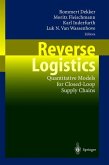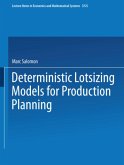The book begins with an easy-to-read introduction to the concepts associated with the creation of optimization models for production planning. These concepts are then applied to well-known planning models, namely mrp and MRP II. From this foundation fairly sophisticated models for supply chain management are developed. Another unique feature is that models are developed with an eye toward implementation. In fact, there is a chapter that provides explicit examples of implementation of the basic models using a variety of popular, commercially available modeling languages. The new edition is updated and provides extensions.
provide models that could be used by do-it-yourselfers and also can be used toprovideunderstandingofthebackgroundissuessothatonecandoabetter job of working with the (proprietary) algorithms of the software vendors. In this book we strive to provide models that capture many of the - tails faced by ?rms operating in a modern supply chain, but we stop short of proposing models for economic analysis of the entire multi-player chain. In other words, we produce models that are useful for planning within a supply chain rather than models for planning the supply chain. The usefulness of the models is enhanced greatly by the fact that they have been implemented - ing computer modeling languages. Implementations are shown in Chapter 7, which allows solutions to be found using a computer. A reasonable question is: why write the book now? It is a combination of opportunities that have recently become available. The availability of mod- inglanguagesandcomputersthatprovidestheopportunitytomakepractical use of the models that we develop. Meanwhile, software companies are p- viding software for optimized production planning in a supply chain. The opportunity to make use of such software gives rise to a need to understand some of the issues in computational models for optimized planning. This is best done by considering simple models and examples.
provide models that could be used by do-it-yourselfers and also can be used toprovideunderstandingofthebackgroundissuessothatonecandoabetter job of working with the (proprietary) algorithms of the software vendors. In this book we strive to provide models that capture many of the - tails faced by ?rms operating in a modern supply chain, but we stop short of proposing models for economic analysis of the entire multi-player chain. In other words, we produce models that are useful for planning within a supply chain rather than models for planning the supply chain. The usefulness of the models is enhanced greatly by the fact that they have been implemented - ing computer modeling languages. Implementations are shown in Chapter 7, which allows solutions to be found using a computer. A reasonable question is: why write the book now? It is a combination of opportunities that have recently become available. The availability of mod- inglanguagesandcomputersthatprovidestheopportunitytomakepractical use of the models that we develop. Meanwhile, software companies are p- viding software for optimized production planning in a supply chain. The opportunity to make use of such software gives rise to a need to understand some of the issues in computational models for optimized planning. This is best done by considering simple models and examples.
From the reviews of the second edition: "This is the second edition of the popular book. ... The book can be used for developing courses for business, management or industrial engineering students. Some developed models are useful not only for teaching purposes but can be immediately applied by practitioners. ... This will be of special value to researchers and PhD students." (Vitaly A. Strusevich, Zentralblatt MATH, Vol. 1140, 2008)








